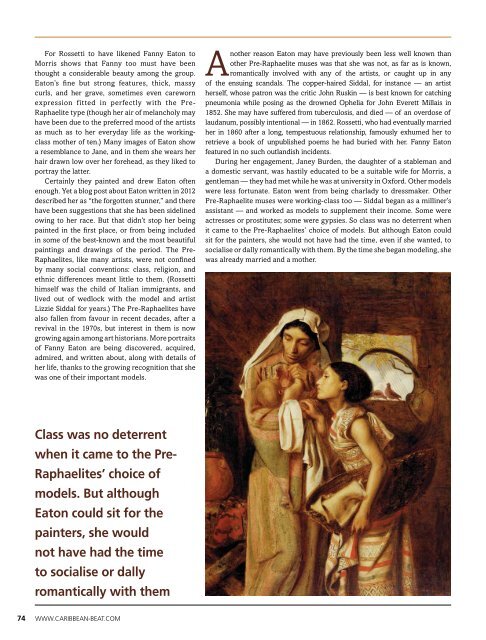Caribbean Beat — January/February 2017 (#143)
A calendar of events; music, film, and book reviews; travel features; people profiles, and much more.
A calendar of events; music, film, and book reviews; travel features; people profiles, and much more.
You also want an ePaper? Increase the reach of your titles
YUMPU automatically turns print PDFs into web optimized ePapers that Google loves.
For Rossetti to have likened Fanny Eaton to<br />
Morris shows that Fanny too must have been<br />
thought a considerable beauty among the group.<br />
Eaton’s fine but strong features, thick, massy<br />
curls, and her grave, sometimes even careworn<br />
expression fitted in perfectly with the Pre-<br />
Raphaelite type (though her air of melancholy may<br />
have been due to the preferred mood of the artists<br />
as much as to her everyday life as the workingclass<br />
mother of ten.) Many images of Eaton show<br />
a resemblance to Jane, and in them she wears her<br />
hair drawn low over her forehead, as they liked to<br />
portray the latter.<br />
Certainly they painted and drew Eaton often<br />
enough. Yet a blog post about Eaton written in 2012<br />
described her as “the forgotten stunner,” and there<br />
have been suggestions that she has been sidelined<br />
owing to her race. But that didn’t stop her being<br />
painted in the first place, or from being included<br />
in some of the best-known and the most beautiful<br />
paintings and drawings of the period. The Pre-<br />
Raphaelites, like many artists, were not confined<br />
by many social conventions: class, religion, and<br />
ethnic differences meant little to them. (Rossetti<br />
himself was the child of Italian immigrants, and<br />
lived out of wedlock with the model and artist<br />
Lizzie Siddal for years.) The Pre-Raphaelites have<br />
also fallen from favour in recent decades, after a<br />
revival in the 1970s, but interest in them is now<br />
growing again among art historians. More portraits<br />
of Fanny Eaton are being discovered, acquired,<br />
admired, and written about, along with details of<br />
her life, thanks to the growing recognition that she<br />
was one of their important models.<br />
Another reason Eaton may have previously been less well known than<br />
other Pre-Raphaelite muses was that she was not, as far as is known,<br />
romantically involved with any of the artists, or caught up in any<br />
of the ensuing scandals. The copper-haired Siddal, for instance <strong>—</strong> an artist<br />
herself, whose patron was the critic John Ruskin <strong>—</strong> is best known for catching<br />
pneumonia while posing as the drowned Ophelia for John Everett Millais in<br />
1852. She may have suffered from tuberculosis, and died <strong>—</strong> of an overdose of<br />
laudanum, possibly intentional <strong>—</strong> in 1862. Rossetti, who had eventually married<br />
her in 1860 after a long, tempestuous relationship, famously exhumed her to<br />
retrieve a book of unpublished poems he had buried with her. Fanny Eaton<br />
featured in no such outlandish incidents.<br />
During her engagement, Janey Burden, the daughter of a stableman and<br />
a domestic servant, was hastily educated to be a suitable wife for Morris, a<br />
gentleman <strong>—</strong> they had met while he was at university in Oxford. Other models<br />
were less fortunate. Eaton went from being charlady to dressmaker. Other<br />
Pre-Raphaelite muses were working-class too <strong>—</strong> Siddal began as a milliner’s<br />
assistant <strong>—</strong> and worked as models to supplement their income. Some were<br />
actresses or prostitutes; some were gypsies. So class was no deterrent when<br />
it came to the Pre-Raphaelites’ choice of models. But although Eaton could<br />
sit for the painters, she would not have had the time, even if she wanted, to<br />
socialise or dally romantically with them. By the time she began modeling, she<br />
was already married and a mother.<br />
Class was no deterrent<br />
when it came to the Pre-<br />
Raphaelites’ choice of<br />
models. But although<br />
Eaton could sit for the<br />
painters, she would<br />
not have had the time<br />
to socialise or dally<br />
romantically with them<br />
74 WWW.CARIBBEAN-BEAT.COM


















